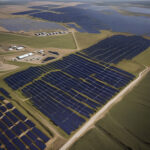Flexible Solar Cell Efficiency Record Smashed by Chinese Scientists at 24.6%
Researchers at the Ningbo Institute of Materials Technology and Engineering (NIMTE) at the Chinese Academy of Sciences have recently made waves in the renewable energy sector by achieving a remarkable efficiency record of 24.6% for flexible solar cells. This groundbreaking achievement not only sets a new benchmark in the field of solar technology but also paves the way for a more sustainable and energy-efficient future.
The traditional solar panels that adorn rooftops and fields have long been a symbol of clean energy production. However, their rigid and bulky nature limits their potential applications. Flexible solar cells, on the other hand, offer a lightweight and versatile alternative that can be integrated into a wide range of surfaces, such as clothing, backpacks, or even curved structures.
The key to the success of the team at NIMTE lies in the innovative approach they have taken to improve the efficiency of flexible solar cells. By utilizing cutting-edge materials and manufacturing techniques, they have been able to significantly boost the conversion rate of sunlight into electricity, surpassing the previous record of 22.3% set by a research group at the Korea Research Institute of Chemical Technology.
One of the major advantages of flexible solar cells is their portability and ease of installation. Unlike traditional solar panels, which require a flat and stable surface for mounting, flexible solar cells can conform to various shapes and contours, making them ideal for applications where space is limited or aesthetics are a concern.
Furthermore, the lightweight nature of flexible solar cells makes them particularly well-suited for mobile and off-grid solutions. Imagine a camping trip where your tent is equipped with solar cells that can charge your devices or a backpack that harnesses solar energy to power your electronics on the go. The possibilities are endless.
In addition to their practical applications, flexible solar cells also represent a significant step forward in the fight against climate change. By harnessing the power of the sun to generate clean electricity, we can reduce our reliance on fossil fuels and decrease harmful greenhouse gas emissions. As the global demand for renewable energy continues to rise, innovations like the one achieved by the researchers at NIMTE will play a crucial role in shaping the future of sustainable energy production.
While the breakthrough in flexible solar cell efficiency is indeed impressive, the journey towards commercialization and widespread adoption is still ongoing. Challenges such as scalability, cost-effectiveness, and durability need to be addressed to ensure that this technology can reach its full potential and make a meaningful impact on the renewable energy landscape.
As we look towards a future powered by clean and renewable energy sources, the work of pioneering research institutions like NIMTE serves as a beacon of hope. By pushing the boundaries of what is possible and reimagining the way we harness solar energy, we inch closer to a more sustainable and environmentally conscious world.
In conclusion, the recent achievement of a 24.6% efficiency record for flexible solar cells by Chinese scientists marks a significant milestone in the advancement of solar technology. With its potential for versatility, portability, and sustainability, flexible solar cells are poised to revolutionize the way we think about energy generation and consumption. As we continue to strive towards a greener future, innovations like this remind us that the power of human ingenuity knows no bounds.
solar, efficiency, Chinese scientists, renewable energy, sustainability












